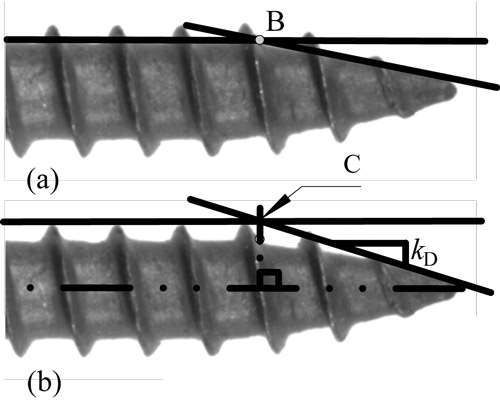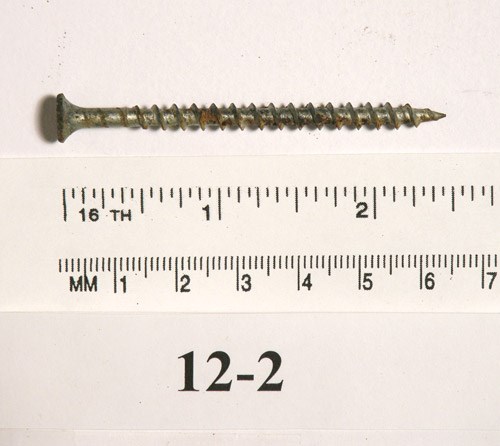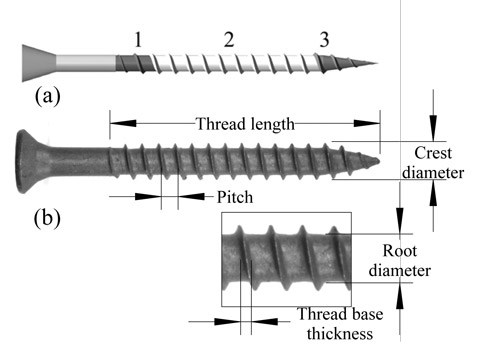How do you measure the surface area of a threaded fastener? How much coating would you put on it? How thick of a coating? What about non-threaded fasteners?
The U.S. Department of Agriculture’s Forest Service, of all people, may have come up with the solution for those pondering how to coat sometimes-difficult small pieces using computer imaging and software to compute the area.
The USDA felt a need to determine surface areas, especially as changes in wood preservative treatments act to accelerate metal fastener corrosion in wood. The agency’s goal is to promote healthy forests and forest-based economies through the efficient, sustainable use of wood, and having fasteners that work well in wood just happens to be part of that goal.
“Accurate identification of the surface area of threaded fasteners is essential for understanding the behavior of fasteners in numerous applications,” says Dr. Samuel Zelinka, a materials research engineer with the Forest Service’s Forest Products Laboratory (Madison, Wisc.). “For example, the surface area of a threaded fastener is needed to properly calculate its corrosion rate.”
This problem has become more perplexed since the voluntary withdrawal of chromated copper arsenate from residential use. Now alkaline wood preservatives such as alkaline copper quaternary and alkaline copper azole are being increasingly used.
“These new alkaline-based preservatives are more corrosive than CCA,” Zelinka says. “But little is known about their corrosion rates on threaded fasteners in contact with the treated wood. This is, in part, due to the fact that, up until now, no general analytical expression of the surface area of threaded fasteners existed, so previous corrosion rate calculations were imprecise.”
Revaluation of Corrosion Potential
Zelinka says that with increasing environmental regulations on the horizon, it is likely wood preservatives will be modified on a more frequent basis, thus requiring a revaluation of the corrosion potential of all fasteners in these new treatments.
Zelinka and research engineer Douglas Rammer say the corrosion of fasteners in preservative-treated wood often requires a time-consuming evaluation process that only results in relative comparison of metals and metallic coatings.
They realize this can be costly and time consuming for fastener manufacturers that are developing new coating systems, which is why they have helped lead the effort to develop electrochemical techniques offering a screening method that has the advantage of being both rapid and quantitative.
Their recent work at the Products Laboratory has demonstrated that these techniques can be extended to polymer-coated fasteners, and a critical parameter is determination of the fastener surface area.
“Until lately, the use of electrochemical test methods has been limited to simple geometries for surface area determination,” Rammer says. “But we’ve now developed a method to evaluate the surface area of threaded fasteners for the corrosion performance, and we would like to make it available for inclusion in the fastener industry’s product development and inspection control.”
Ideally, the USDA Forest Service wants to partner with a coating or fastening company to co-develop the technique.
Optical Technology for Determining a Fastener’s Surface Area
The agency’s product—which doesn’t have a name yet—uses an optical method and equipment that somehow determines the surface area of a threaded fastener from high-contrast digital images. It works by taking a digital image of the fastener, separating the image into regions and then determining the corresponding surface area for each region using an analytical expression developed by the researchers. The surface areas of the three regions are then added together in order to get the surface area of the entire fastener. The agency says this method is versatile enough to also determine the surface area of non-threaded fasteners.
“For threaded fasteners, the key characteristics that are needed to determine the surface area from the acquired images include the root diameter, the thread crest diameter, the thread length, the thread width at the root diameter and the thread transitions, which is the location between fastener tip and constant shank region,” Zelinka says.
Essentially, the idea is to take a high-contrast image, break the complicated fastener geometry into smaller, defined segments with known analytical solutions, calculate the surface area of each individual segment, and add the individual segments to determine the total surface area of the threaded fastener.
“This method has been successfully used to determine the surface area of threaded fasteners used in recent experiments to determine the corrosion rates of fasteners in different preservative environments,” Zelinka says.
For example, in order to demonstrate the efficacy of the surface area algorithms, the surface area of a No. 10 (2.54 cm) wood screw was calculated. The parameters of the screw are specified by ASME 8, and these parameters were used to generate a geometric model to test the algorithm. The mathematical and actual images are remarkably similar and lend validation to the developed expression, the researchers say.
Applications Are Many
Zelinka and Rammer say this research development has significant benefits for numerous applications and industries:
Alternative Wood Preservative Treatments and Fastener Corrosion Rates. Allows for more accurate determination of corrosion rates for threaded fasteners that are in contact with treated wood. Corrosion of threaded fasteners can lead to rust and instability in the structures where alternative wood preservatives like ACQ are used. Their technique should help provide more accurate predictions for the replacement rate of fasteners currently in use.
Metal Plating of Fasteners. Helps metal platers determine the surface area of a threaded fastener prior to plating, allowing for a more accurate determination of the applied coating thickness.
General Fastener Manufacturing. They say the algorithm presented also can be easily incorporated into existing manufacturing equipment, giving manufacturers and testing laboratories greater manufacture control by allowing products to be tested and changed so that problems could be solved prior to production. It should also help reduce costs and improve product quality.
Zelinka says they are looking for collaborators to further develop and commercialize the technology, which has been published as patent application No. US-2008-0126008.
“We believe this product provides a necessary and useful tool for manufacturers and testing laboratories, especially as changes in wood preservative treatments act to accelerate metal fastener corrosion in this wood,” he says. n
For more information, contact Douglas Rammer at 608-231-9266 or at drammer@fs.fed.us, and Samuel Zelinka at 608-231-9277 or at szelinka@fs.fed.us.
RELATED CONTENT
-
Julie Holmquist of Cortec Corporation discusses passivating corrosion on rebar and other reinforcing metals.
-
PPG renews its commitment to heavy-duty equipment coatings with Caterpillar as it is selected the company’s industrial coatings business as the sole heavy-duty equipment coatings supplier for a new motor grader assembly plant in North Little Rock, Ark.
-
Caterpillar has been developing and applying advanced wear coatings to extend the service life and performance of its machine components, whether new or remanufactured, for decades. Now Caterpillar’s advanced wear coatings are available to others through Cat Remanufacturing, including turnkey coating and finishing.



















